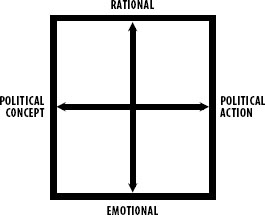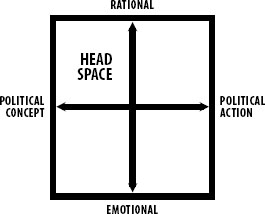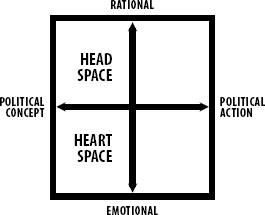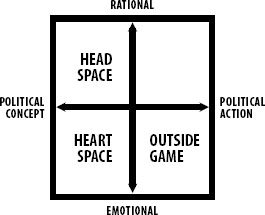Rebuild the Dream (20 page)
Authors: Van Jones

Â
.
4
THE GRID
Heart Space, Head Space, Inside Game, and Outside Game
W
E HAVE EXAMINED THE SUCCESS
of the 2008 Obama campaign (and the subsequent bursting of the hope bubble) and rise of the Tea Party and Occupy Wall Street movements.
Could there be a way to weave the lessons from each into a coherent picture? This Section presents the three frameworks at which I arrived as I tried to make sense of it all. And this chapter takes up the first framework. I call it the “Heart Space/Head Space Grid.”

SUBCONSCIOUSLY, MANY OF
us think about politics as a linear process. We see political change running along a horizontal axis, from political concept to political action.
A political concept is something that one thinks, values, or believes in, regarding the public or common good. A political action is a step that can be taken to do something about itâeither through citizen action or government action, or a combination of both.

It seems logical that once a problem is studied and a solution is identified (political concept), then citizen-activists and politicians should be able to explain the issue rationally and have the citizens and government implement solutions (political action). This notion of political process is one particularly embraced by liberals and progressives.
Yet, as famed linguist, George Lakoff notes, “Liberals have the idea that if you just tell people the facts, people will be rational and reach the right conclusion. The facts will set you free. They won't!” Indeed, progressives find themselves constantly frustrated and exasperated when the real world refuses to conform to this mental construct. We accuse our conservative rivals of being stupid or crazy because they won't behave as this model suggests they should. Some of us heave a deep sigh at the “rest of the country,” the part that lies beyond the coasts and college towns. We shake our heads, assuming that the land must be filled with legions of ignorant people, since their actions so often defy the dictates of this mental model.
But what if it turns out that progressives are the ignorant ones?
Ignorant
âunknowing ofânot
stupid
. Maybe we are ignorant of some thingsâmeaning we lack some important insight into the way change actually works in America. Might we have some learning,
rethinking, and growing to do? After all, we are the ones who consistently do the same things in politics, often getting results we don't like, yet we continue behaving in exactly the same way, all the while expecting radically different outcomes. (There is a word in clinical psychology for people who behave this way: insane). Maybe, based on our positive and negative experiences over the past few years, it is time for us to amend our worldviewâso that we can better understand the people we are trying to influence and the systems we are trying to change.
Emotions matter in politics. Many progressives pride themselves on being fully rational; they look down their noses at the red-faced emotionalism of the right-wingers whom we see screaming themselves hoarse on
Fox News
. But the truth is that we are just as emotive. Our wiring is just different.
For instance, many of us will weep in traffic, listening to some tearjerker of a story on National Public Radio (NPR). We seethe and rage about injustices overseas, in countries we have never visited. We will give away our hard-earned money to save the habitat of some endangered animal that would probably eat us alive, if we ever ran into it in the wild. No matter how many times we hear Dr. King's “I Have A Dream” speech, we still choke up. For all our attempts to rationalize and intellectualize our worldview, we are just as emotionally driven as our more right-wing peers, if not more so.
So what if we were to integrate into our model another dimension, beyond the rational?
If we expand the framework to include that new dimension, it would look like this:
To the original process model of concept-to-action, I have added a vertical axis that runs from rational-to-emotional. You can
think of this as running from the head to the heart. Adding this dimension creates the
Heart Space/Head Space Grid.

The grid gives us four quadrants to play with, not just two poles. These quadrants depict the political process as a combination of
1. Rational + Conceptual (Head Space)
2. Emotional + Conceptual (Heart Space)
3. Emotional + Actionable (Outside Game)
4. Rational + Actionable (Inside Game)
Let's begin in the upper left quadrant of the grid, where the Rational + Conceptual meet. I call this quadrant the “Head Space.” This is the home of the think tanks, academics, and policy wonks.
Here, among facts and rational arguments, the stereotypical liberal intellectual will feel the most comfortable. Here the world sounds like NPR and reads like the
New York Times
. The sentences are long, the arguments are nuanced, and the numbers are precise. This is an important space: one cannot make meaningful, effective, and lasting change without a sober view of the data combined with sound policy prescriptions.

As I have said, politics is not just about what goes on in one's head. Politics is fueled not only by the ideas we hold and communicate rationally. How many people vote for a candidate based merely on brains versus based on looks, charisma, trustworthiness, or
je ne sais quoi
? Politics is also about what happens in one's heart. That is why I call the lower left quadrant, where the emotions have sway, the “Heart Space.” This quadrant is home to the great storytellers,
artists, preachers, and other resonant communicators. Politics is energized by the emotions: feelings of love and rage, contempt and compassion, pride and shame. Its building blocks are those
stories
that make us want to raise our fists or that leave us with a lump in our throats. At their most powerful, political ideas touch our souls. They arouse our passions. If going into the Head Space feels like going to school, then going into the Heart Space feels like going to a powerful concert or stepping into churchâa rowdy, evangelical church. If the Head Space is needed for education, then the Heart Space is needed for inspiration and motivation.

Once people become touched, moved, or inspired in the Heart Space, then they will want to take action. In fact, rather than being highly motivated by factual argument or dispassionate calculation, people are more likely to be inspired to take action
based on their emotions. This is what happens in the grid's lower right quadrant, where emotion and action meet: the “Outside Game.” This is the home of activists and volunteers. In this quadrant, people go to rallies, pester their friends to sign online petitions, organize door-to-door campaigns, “like” and share information on Facebook or Twitter, make donations, wear T-shirts, make T-shirts, affix bumper stickers to their cars, and display signs in their front yards. Here people are not taking actions based on their immediate, rational self-interest. Few are likely to get a jobâwhether it's a contract position or a high-level government postâif their cause or candidate prevails. Sometimes the practical result of their efforts might be an increase in their own taxes (liberals) or cuts to social programs that they enjoy or rely upon (conservatives). Often, the lofty vision or goals that inspire their actions may not even be realizable in their lifetimes, if ever. But they are so moved that they take action based simply on what they feel is rightâwhat moves them in their hearts.

That brings us to the final quadrant, the upper right grid territory where reason meets action. I call this space the “Inside Game.” This is the home to the elected officials, paid lobbyists, and party operatives, including staff members at the legislative and bureaucratic levels. These are the people with the formal authority to make binding decisions, or they are the people who have enough power, standing, access, or influence to impact the behavior of the decision makers. In this space, there is very little room for misty-eyed idealism; this is the land of rational calculationâthe world of threats and bribes. This is the natural home of the dealmaker. Cold-blooded maneuver and the necessary compromise are the currency of this realm.
